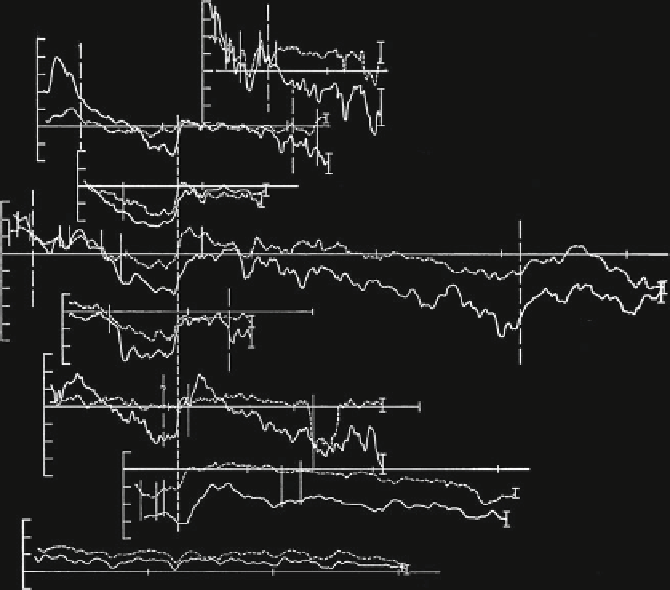Geoscience Reference
In-Depth Information
S
A
S
G
S
S
G
S
A
32
16
8
4
1
SERIES 1
B
1
S
2
1
1/2
1/4
A
A
SERIES 2
S
B
A
1
SERIES 3
8
4
2
1
1/2
1/4
1/8
1/16
S
SS S
B
S
S
G
S
SERIES 4
S
100
300
400
500
B
S
1
A
1/32
8
4
2
1
1/2
SERIES 5
B
B
S
B
S
SERIES 6
1/4
1/8
1/16
B
S
S
I
SERIES 7
S
G
S
8
4
2
1
1/2
SERIES 8
100
200
300
TIME IN YEARS
Fig. 6.4 Filtered curves for thickness data, series 1-8.
Solid lines
denote silt thickness,
broken lines
for clay thickness. A-A is boundary between sandy and silty facies, B-B is boundary between silty
and diamictic facies, s slumped intervals, G gaps in record with 5-10 varves missing. Width of 95 %
confidence belt is shown at end of each series (Source: Agterberg and Banerjee
1969
,Fig.7)
c
and
a
are constants are shown for
m
50. Deming's (
1948
)method
of least squares for exponentials was used for the curve-fitting. Clearly, the
correlogram curves (original data and lines of best fit) intersect the vertical
axis at points that are less than one. This indicates the presence of random
(uncorrelated) noise with variance of standardized data equal to (1
¼
10 and
m
¼
c
). This
white noise can be removed from the data by using the filter of Box
6.2
as
follows.
Application of the semi-exponential filter to series 4, silt, (with
m
¼
10) yielded,
a
0.17 (
cf.
Agterberg and Banerjee
1969
)
indicating that the bilateral filter used to derive the relatively smooth “signal” in
Fig.
6.4
is restricted to a relatively narrow neighborhood. Six of the eight series
shown in Fig.
6.4
were aligned with respect to one another on the basis of the
“datum” which is a relatively abrupt increase in thickness of the varves. This datum
¼
0.022,
c
¼
0.72,
p
¼
0.33 and
q
¼

Search WWH ::

Custom Search